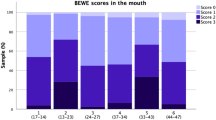Abstract
In this study, we analyzed a newly developed optical reflectometer for measuring erosive tooth wear (ETW) in vitro. Three examiners independently assessed the labial surface of 80 deciduous canines and 75 permanent incisors. One examiner performed visual examinations (BEWE), and the other two used the optical pen-size reflectometer to measure surface reflection intensity (SRI) on the same labial surfaces. The examinations were made in duplicate with at least 1 week interval. Intra- and inter-rater agreements were calculated using weighted kappa analysis for BEWE, and intra-class correlation coefficients (ICC) as well as Bland-Altman plots for SRI. The teeth were separated into without (BEWE 0) or with (BEWE 1–3) ETW, and SRI cut-off points were calculated. Intra-rater agreement for the visual examination was 0.46 and 0.82 for deciduous and permanent teeth, respectively. Inter-rater and intra-rater agreement for SRI were good (ICC > 0.7; p < 0.001). SRI measurements produced high specificity values for deciduous and permanent teeth (≥0.74 and ≥ 0.84, respectively), and lower sensitivity values (≥0.37 and ≥ 0.64, respectively), but permanent teeth had generally higher SRI values (p < 0.05). We observed a significant association between BEWE and SRI (p < 0.05). The optical pen-size reflectometer was able to adequately differentiate ETW on permanent teeth, with highly reliable and reproducible measurements, but ETW on deciduous teeth was less accurately differentiated. The reflectometer is a good candidate for clinical research.



Similar content being viewed by others
References
Carvalho TS, Colon P, Ganss C, Huysmans MC, Lussi A, Schlueter N, Schmalz G, Shellis RP, Tveit AB, Wiegand A (2015) Consensus report of the European Federation of Conservative Dentistry: erosive tooth wear—diagnosis and management. Clin Oral Investig 19:1557–1561
Shellis RP, Barbour ME, Jesani A, Lussi A (2013) Effects of buffering properties and undissociated acid concentration on dissolution of dental enamel in relation to pH and acid type. Caries Res 47:601–611
Lussi A, Schlueter N, Rakhmatullina E, Ganss C (2011) Dental erosion—an overview with emphasis on chemical and histopathological aspects. Caries Res 45(Suppl 1):2–12
Ganss C, Lussi A (2014) Diagnosis of erosive tooth wear. Monogr Oral Sci 25:22–31
Bartlett D, Ganss C, Lussi A (2008) Basic erosive wear examination (BEWE): a new scoring system for scientific and clinical needs. Clin Oral Investig 12(Suppl 1):S65–S68
Rakhmatullina E, Bossen A, Höschele C, Wang X, Beyeler B, Meier C, Lussi A (2011) Application of the specular and diffuse reflection analysis for in vitro diagnostics of dental erosion: correlation with enamel softening, roughness, and calcium release. J Biomed Opt 16:107002
Brevik SC, Lussi A, Rakhmatullina E (2013) A new optical detection method to assess the erosion inhibition by in vitro salivary pellicle layer. J Dent 41:428–435
Lussi A, Bossen A, Höschele C, Beyeler B, Megert B, Meier C, Rakhmatullina E (2012) Effects of enamel abrasion, salivary pellicle, and measurement angle on the optical assessment of dental erosion. J Biomed Opt 17:97009–1
Rakhmatullina E, Bossen A, Bachofner KK, Meier C, Lussi A (2013) Optical pen-size reflectometer for monitoring of early dental erosion in native and polished enamels. J Biomed Opt 18:117009
Walter SD, Eliasziw M, Donner A (1998) Sample size and optimal designs for reliability studies. Stat Med 17:101–110
Huysmans MC, Kühnisch J, ten Bosch JJ (2005) Reproducibility of electrical caries measurements: a technical problem? Caries Res 39:403–410
Rodrigues JA, Hug I, Diniz MB, Lussi A (2008) Performance of fluorescence methods, radiographic examination and ICDAS II on occlusal surfaces in vitro. Caries Res 42:297–304
Carvalho TS, Lussi A, Jaeggi T, Gambon DL (2014) Erosive tooth wear in children. Monogr Oral Sci 25:262–278
Acknowledgments
We are very grateful to Isabel Hug and Marie-Loise Stämpfli from our department for their assistance in this work. We also show our gratitude to RP Shellis for his valuable comments and suggestions to this manuscript.
Author information
Authors and Affiliations
Corresponding author
Ethics declarations
Conflict of interest
The authors declare that they have no conflict of interest.
Funding
One of the co-authors received a PhD scholarship from CAPES Foundation (Ministry of Education, Brazil).
Ethical standards
This article did not require the approval of an ethical committee, as detailed in the “Materials and methods” section.
Informed consent
For this type of study, formal written consent is not required.
Rights and permissions
About this article
Cite this article
Carvalho, T.S., Assunção, C.M., Jost, F. et al. In vitro validation of a hand-held optical reflectometer to measure clinically observed erosive tooth wear. Lasers Med Sci 31, 1105–1112 (2016). https://doi.org/10.1007/s10103-016-1957-0
Received:
Accepted:
Published:
Issue Date:
DOI: https://doi.org/10.1007/s10103-016-1957-0




